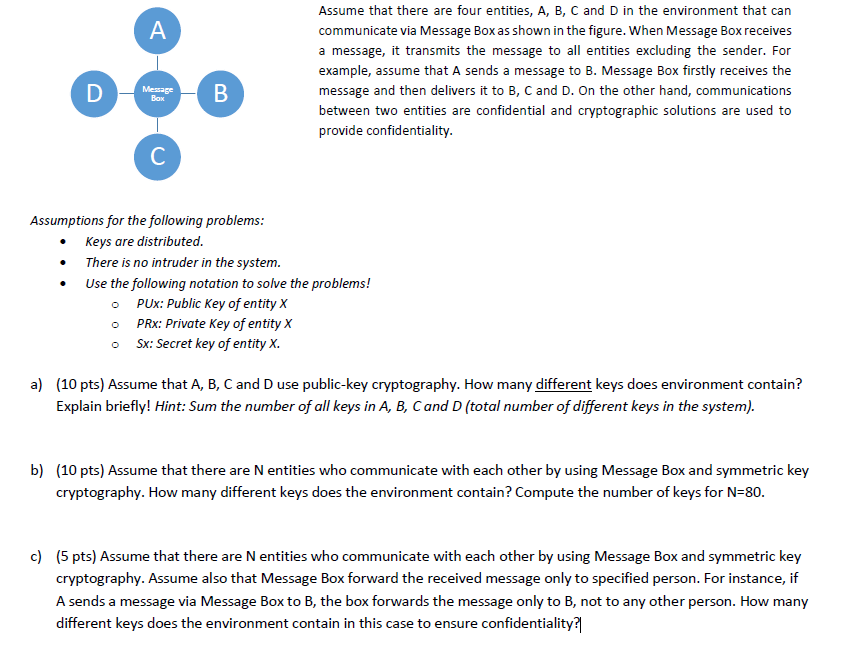
A Assume that there are four entities, A, B, C and D in the environment that can communicate via Message Box as shown in the figure. When Message Box receives a message, it transmits the message to all entities excluding the sender. For example, assume that A sends a message to B. Message Box firstly receives the message and then delivers it to B, C and D. On the other hand, communications between two entities are confidential and cryptographic solutions are used to provide confidentiality. D Message Box B C Assumptions for the following problems: Keys are distributed There is no intruder in the system. Use the following notation to solve the problems! O PUX: Public Key of entity X PRx: Private Key of entity X Sx: Secret key of entity X. a) (10 pts) Assume that A, B, C and D use public-key cryptography. How many different keys does environment contain? Explain briefly! Hint: Sum the number of all keys in A, B, C and D (total number of different keys in the system). b) (10 pts) Assume that there are N entities who communicate with each other by using Message Box and symmetric key cryptography. How many different keys does the environment contain? Compute the number of keys for N=80. c) (5 pts) Assume that there are N entities who communicate with each other by using Message Box and symmetric key cryptography. Assume also that Message Box forward the received message only to specified person. For instance, if A sends a message via Message Box to B, the box forwards the message only to B, not to any other person. How many different keys does the environment contain in this case to ensure confidentiality? A Assume that there are four entities, A, B, C and D in the environment that can communicate via Message Box as shown in the figure. When Message Box receives a message, it transmits the message to all entities excluding the sender. For example, assume that A sends a message to B. Message Box firstly receives the message and then delivers it to B, C and D. On the other hand, communications between two entities are confidential and cryptographic solutions are used to provide confidentiality. D Message Box B C Assumptions for the following problems: Keys are distributed There is no intruder in the system. Use the following notation to solve the problems! O PUX: Public Key of entity X PRx: Private Key of entity X Sx: Secret key of entity X. a) (10 pts) Assume that A, B, C and D use public-key cryptography. How many different keys does environment contain? Explain briefly! Hint: Sum the number of all keys in A, B, C and D (total number of different keys in the system). b) (10 pts) Assume that there are N entities who communicate with each other by using Message Box and symmetric key cryptography. How many different keys does the environment contain? Compute the number of keys for N=80. c) (5 pts) Assume that there are N entities who communicate with each other by using Message Box and symmetric key cryptography. Assume also that Message Box forward the received message only to specified person. For instance, if A sends a message via Message Box to B, the box forwards the message only to B, not to any other person. How many different keys does the environment contain in this case to ensure confidentiality







